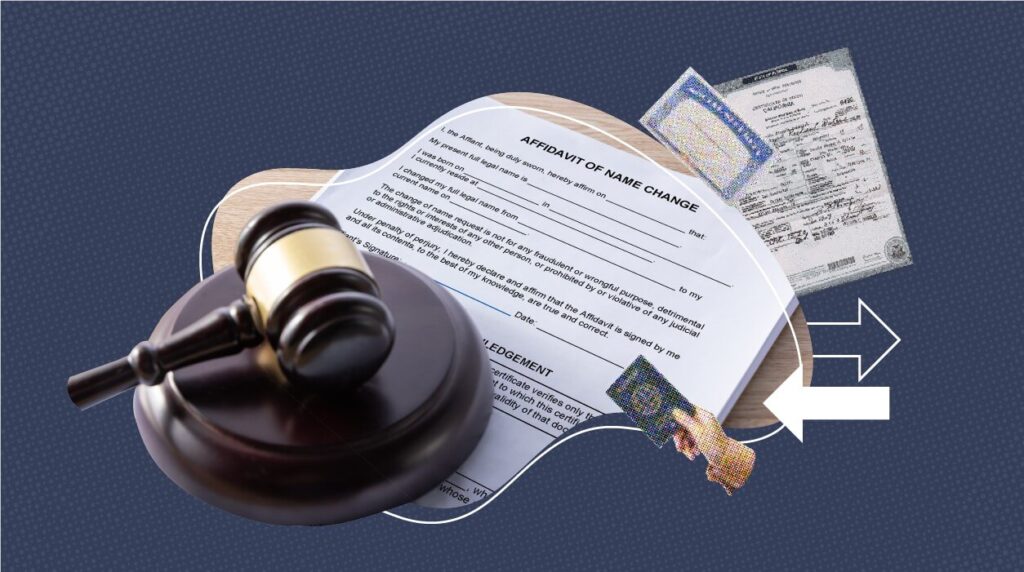Table of Contents:
- What Is a Name Change Affidavit?
- How to Complete a Name Change Affidavit
- Why Do People Need to Complete Name Change Affidavits?
- Mistakes to Avoid With Name Change Affidavits
It would be nice if changing your name was as simple as using a new one. That’s not the case. Before you can legally begin using a new name, you must complete a legal process. It requires contacting agencies, completing paperwork, and gathering information.
Whether for personal reasons or due to legal requirements, such as a marriage or divorce, a name change affidavit is vital to ensure your name-related transition is recognized legally.
What Is a Name Change Affidavit?
Understanding this document means learning about the meaning of an affidavit, a legal document containing a statement sworn to be true. It’s also usable in court proceedings, especially in place of live testimonies. Affidavits are also usable to verify someone’s residency, receive government benefits, and complete tax-related requests.
A name change affidavit is a legally binding sworn statement of your intention to change your name.
Your affidavit will include the following:
- Your new name
- Your current name
- Why you want to change your name
- Your signature
- A signature from a notary public
Besides what’s on this form, you’ll also need to present supporting documents. We’ll cover what you need in the section below.
How to Complete a Name Change Affidavit

Thankfully, legally changing your name without a court order is easier than it sounds. This process requires completing several steps.
Gather Supporting Documents
Set yourself up for success by getting the supporting information you need before you begin filling out your name change form. What qualifies as supporting documents depends on why you’re changing your last name.
Someone completing an affidavit of name change after marriage would present a marriage certificate. Recent divorcees would submit a divorce decree if changing their surname post-divorce.
You’ll also likely need your driver’s license, passport, or applicable state ID to complete a name change affidavit in addition to your Social Security-related information.
Complete Your Affidavit
With your information at your side, you’re ready to fill out your affidavit. Fortunately, most jurisdictions offer pre-made forms. These papers let people fill in the blank areas with their information. It speeds up the name change process.
You’ll also need to speak with a notary public. This individual plays a vital role. They must look over and sign your affidavit.
Submit Your Affidavit
The final step is ensuring you follow your jurisdiction’s requirements for submitting affidavits. Some areas might require you to submit this form in person. Other vicinities might allow applicants to send their affidavits by mail or online.
Why Do People Need to Complete Name Change Affidavits?
While you might not be familiar with this document, people use it in a variety of situations. Some of the most common reasons to need this affidavit include:
Getting Married or Divorced
A common reason people need to change their names is due to marriage. Someone might take their spouse’s last name or blend their last names, such as an individual hyphenating their last name with their spouse’s surname. No matter which option you choose, you’ll likely need an affidavit of name change after marriage.
However, marriage isn’t the only reason someone would require a surname change. Someone getting divorced is likely to change their last name to what it was before marriage.
Whether you’re marrying or divorcing, using the appropriate affidavit to change your job simplifies this process of updating records when court orders aren’t required.
Adoptions
Adopting a child or being adopted also typically requires someone to change their name to reflect being part of a new family. Completing a required affidavit lets a newly adopted individual enroll in school, obtain a driver’s license, and more under their new name.
Your Personal Preference
Not all name changes are based on legal requirements, such as using an affidavit of name change after marriage. You may wish to change your name to reflect your personal preferences or cultural background. If your jurisdiction doesn’t require a court order for personal name changes, a name change affidavit can serve as a valid way to obtain your new legal name.
Mistakes to Avoid With Name Change Affidavits
- Rushing the Process: Wanting to complete paperwork quickly is understandable. However, remember that mistakes will only lengthen the time it takes to change your name. Review your information carefully.
- Not Notifying the Proper Parties: After completing and submitting your affidavit, you must also notify the Social Security Administration, the IRS, your employer, and your bank of your new name.
- Ignoring Jurisdictional Requirements: Different states, counties, and cities have varying rules regarding their respective name change processes. Verify these requirements before submitting your affidavit.
Changing your name is an important step many will take in their lifetimes. Often, this process requires tracking down and presenting birth, death, marriage, and divorce certificates. Choose Vital Records Online for help requesting and receiving certified copies of these crucial documents.

